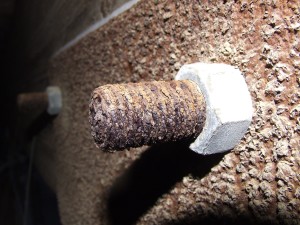Corrosion Evaluations

Determination of corrosion mechanisms and sources is vital do the determination of systems failures and failure prevention. Several tools are available for identification of corrosion constituents, pathways, and ultimately failure mode. Conclusive statements can be made regarding sources and conditions that lead to the corrosion mechanisms as well as test methods employed to determine susceptibility to corrosive attack.
| Methods | Industry Standard and Proprietary |
| Sample Size | Various |
| Types of Material | Alloys of iron, aluminum, copper, zinc, magnesium, tin, nickel |
We can break down corrosion evaluation into two different categories:
- Evaluation of an unknown corrosion mechanism after it has the appearance of occurring
- Evaluation of corrosion mechanisms by environmental simulation or acceleration
Evaluation of an Unknown Corrosion Mechanism After it has the Appearance of Occurring
The general nature of these inquiries revolves around the identification of a deposit, residue, apparent corrosion product, or evidence of material (substrate) pitting or degradation. These inquiries will typically involve chemical and morphological evaluation of the particular substance(s) that have led to the inquiry and/or evaluation of the substrate and anomaly occurring. For identification of the residues can be paramount in understanding the underlying mechanism. Is the residue simply a foreign deposit that had no deleterious effect on the substrate? Or is the deposit simply an uncatalyzed corrosion product of the affected substrate?
To understand or discount mechanisms for generation of these conditions, a comprehensive examination of the entire system should be conducted. Isolation of the residues away from the substrate to understand the chemical and morphological constituents is key. For these evaluations, Scanning Electron Microscopy, Energy Dispersive X-ray Spectroscopy, and Fourier Transform Infrared Spectroscopy are specified for a comprehensive examination of the isolated residue. In addition, X-ray diffraction as a secondary step can help identify the forms and oxidation states of the identified inorganic compounds and oxides.
After examination of the residues, understanding the effects on the substrate of concern is called upon. A comprehensive surface examination can be conducted using optical microscopic and Scanning Electron Microscopy techniques to understand the corrosion or lack of corrosion mechanisms.
Depending on the nature or outcome of this investigation, cross-sectioning through an affected region can reveal metallurgical information also important in determining root physical cause. This tool can yield information about the underlying metallurgy that may be in a condition that is amenable to certain corrosive mechanisms that simply could not be determined from chemistry alone (for example, intergranular attack assessment in stainless steels).
The seasoned corrosion investigator will put all of these tools and assessment to use in identifying the ultimate root physical cause of the corrosion mechanisms. At RTI, we have the tools and the expertise to provide comprehensive corrosion and corrosion failure evaluations.
Evaluation of Corrosion Mechanisms by Environmental Simulation or Acceleration
In the laboratory setting we use environmental exposure testing to simulate or accelerate environmental conditions that will induce corrosion in the subject materials. In the standardized testing world many testing specifications exist that dictate the environmental conditions for exposure, including: time, temperature, relative humidity, chemistry of exposure solutions, and ramp rates between conditions. Some of these exposures are relatively simple and involve steady state exposures, however more-so alternating conditions are specified which dictate a “cycle”
More often than not, these specifications will involve containment in chambers that are specifically designed for the size and configuration of the components being tested as well as the conditions of the exposure. These cabinets will be able to precisely control and monitor/record the time, temperature, humidity, pressures, and chemical application flow rates.
Methods of chemical application are also specified and control such as a FOG (mist), spray, reciprocating spray, and/or immersion.
Environmental exposure methods will include the following general references that can be evaluated by exposure:
- Cyclic Corrosion (CCT)
- Cyclic Immersion
- Salt Spray (FOG) – generally NaCl
- Condensing and non-condensing humidity
- Seal Compatability
- Fluid Resistance
- A.S.S.
- Filiform Corrosion
The evaluation of samples includes periodic inspections (either governed by client consensus or the standard) and include evaluation of parameters such as the following:
- Size and density of ferrous corrosion
- Size and density of non-ferrous corrosion
- Organic coatings evaluation of scribe creepback or adhesion
- Presence/absence of filiform corrosion
- Functional evaluation (does the part still work or actuate?)
The organizations that author and compile standard specifications for testing are familiar in other parts of the testing world and include:
For a list of complete environmental exposure specifications offered by the laboratory, please visit our environmental exposure page

